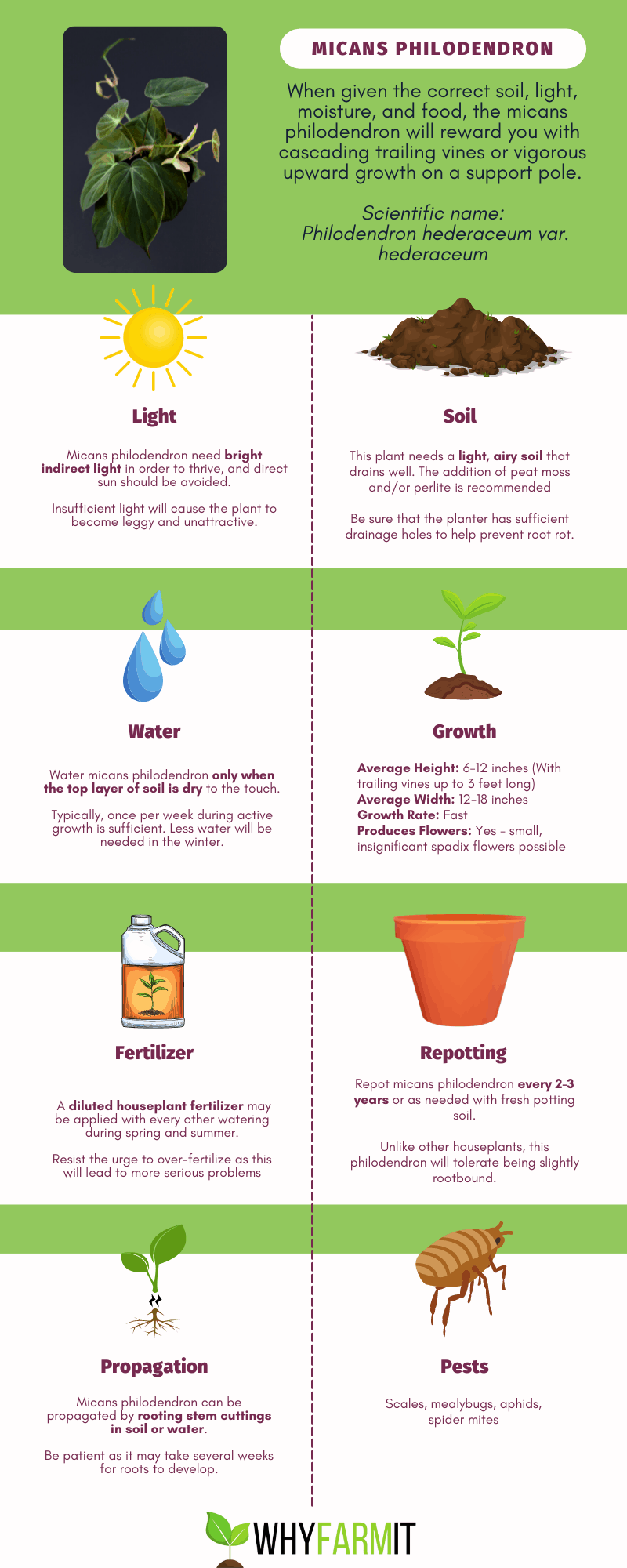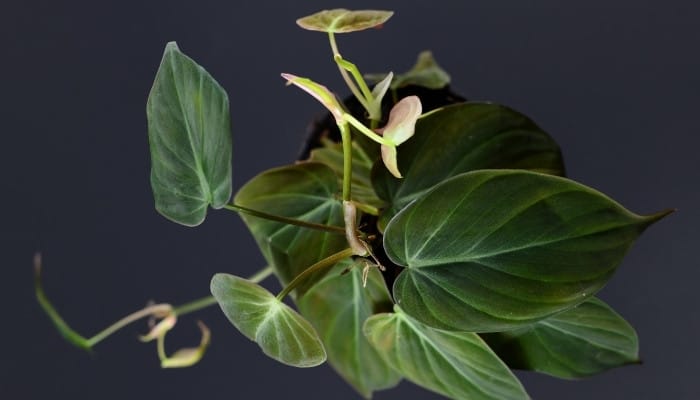The Micans philodendron, known for its heart-shaped leaves resembling velvet, has gained significant popularity as an indoor plant.
The undersides of the leaves are purple and the green tops have a soft sheen to them. They add a unique texture to any houseplant collection.
How do you care for micans philodendron? Philodendron ‘Micans’ does best in a light, airy soil that drains well. Provide bright, indirect sunlight, and water when the top few inches of soil are dry. Keep humidity high and maintain temperatures between 65 and 80℉. A light application of fertilizer may be applied every other watering.
Caring for Micans Philodendron: Basic Guidelines
Micans philodendron has become easier to find since its rise in popularity, so it is common to it find for sale online.
However, to achieve a large, luscious plant, you will need to give the plant proper care. This article will tell you everything you need to know to care for your micans philodendron.
Complete Care Guide for Micans Philodendron
Micans Philodendron has quite a few common names, including Philodendron ‘Micans’, velvet leaf philodendron, sweetheart philodendron, and heart leaf philodendron.
These names stem from confusion around the scientific name of the plant. Botanists have historically disagreed over the relatedness of many Philodendron species.
At present, Philodendron hederaceum var. hederaceum is the correct scientific name, though you’ll still frequently run across the name Philodendron scandens ‘Micans’.
Micans Philodendron at a Glance
- Plant Type: Tropical perennial
- Scientific Name: Philodendron hederaceum var. hederaceum and Philodendron scandens ‘Micans’
- Average Height: 6-12 inches (with vines reaching over 3 feet long)
- Average Width: 12-18 inches
- Growth Rate: Fast
- Produces Flowers: Yes – small spadix flowers
- Common Pests: Sap-sucking insects, spider mites
- Life Expectancy: Perennial with proper care
- Difficulty of Care: Easy
Ideal Soil for Micans Philodendron
The ideal soil for micans philodendron is a well-draining indoor potting mix. If needed, you can add peat moss or perlite to increase aeration and drainage in the soil.
If the soil does not allow excess water to drain, it can cause the roots to sit in water and suffer from root rot.
Micans Philodendron Water Requirements
Micans philodendron has moderate water needs. The most important thing to do is always check your soil before watering.
The top inch or two should be dry before you water the plant. This helps prevent over-watering and potential root rot from forming.
While this plant will survive short drought periods, it is advised to not let micans philodendron dry out completely.
You will know that the soil is too dry when it becomes a lighter color and pulls away from the edges of the pot.
For most plants, you will need to water (approximately) once per week in the summer and once per month in the winter.
Micans Philodendron Lighting Needs
Micans philodendron does best in bright, indirect light. It can tolerate small amounts of direct sunlight, but long hours or harsh afternoon sun should be avoided.
This plant will survive in lower light levels, but it is not optimal. Lower light will cause the plant to become leggy (longer distance between the leaves) and produce smaller leaves.
Ideal Temperature and Humidity for Micans Philodendron
This is a tropical plant, so it should be kept warm. The ideal temperature range is 65-80℉, which is usual room temperature.
Micans philodendron loves humidity. It will be its healthiest when provided high levels of humidity.
You can increase the humidity around your plant by misting the leaves periodically (which is also great for cleaning them), placing the pot on a pebble tray (here’s how), or using a humidifier (this one is ideal).
Micans Philodendron Growth Habits
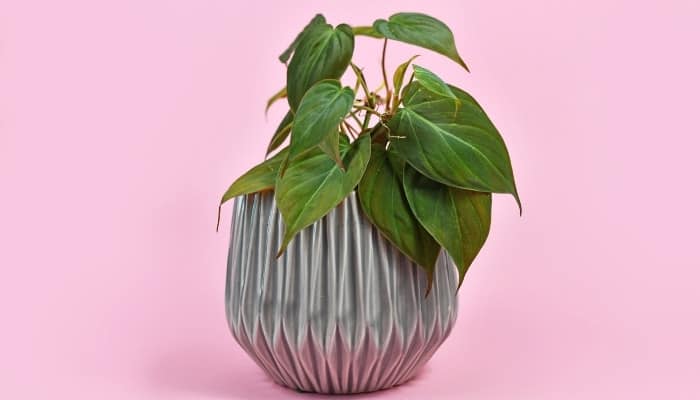
Micans philodendron is a vining or climbing plant. Depending on the container and location, it will either climb up a structure using aerial roots or it will grow lone vines that trail out of the container.
It is recommended to give the plant a moss pole to climb if you would like a taller and fuller looking plant. I recommend these moss poles as they are stackable so that they can “grow” with your plant.
With the proper environment and care, micans philodendron is a fast grower that will put out tons of new growth during the growing season.
Fertilization Type & Schedule for Micans Philodendron
Use a liquid houseplant fertilizer for micans philodendron. During the growing season, you can add the fertilizer to your watering can every other watering.
Stop fertilizing completely during the winter when growth slows or stops.
Signs of Nutrient Deficiency
Yellowing leaves is the most common sign of nutrient deficiency in micans philodendron. In addition, the plant as a whole may look limp and lackluster.
If you believe your plant is suffering from a nutrient deficiency, be careful not to over fertilize the plant as compensation. Too many nutrients can also cause health problems for the plant.
Pruning Micans Philodendron
Pruning your micans philodendron is only necessary for aesthetic reasons. By pruning the longer vines, you can cause the plant to branch out and create a fuller look.
Does Micans Philodendron Produce Flowers?
In the right conditions, micans philodendron can produce flowers. However, the flowers are generally seen as unattractive, and many hobbyists will remove the flower stalks to preserve plant energy.
Is Micans Philodendron Toxic?
Micans philodendron is toxic to both humans and animals. Keep the plant in a location where pets and children will not accidentally ingest any parts of the plant.
Micans Philodendron Propagation
The easiest way to propagate micans philodendron is through water propagation of a stem cutting. This allows you to see when roots have grown long enough for the cutting to be planted.
1. Remove a Stem Cutting
If you are pruning your plant, this is a great time to take a stem cutting. Your stem cutting should have at least one leaf and one node (location where the leaf meets the stem).
2. Place the Cutting in Water
Place the stem cutting into a container of clean water. The node should be submerged in the water and any leaves should be above the surface.
3. Allow Roots To Grow
Place the cutting in a warm location that receives bright, indirect light. Change the water every other day to prevent bacteria and fungal issues.
It can take a few weeks for roots to form and grow 2-3 inches long.
4. Transfer Cutting to Soil
Once your roots are 2-3 inches long, you can transfer your cutting into a pot of soil. Keep the soil moist for the first couple of weeks to help the roots acclimate to living in soil.
Soil Propagation
You can skip water propagation and place your stem cutting directly into soil. It is important to keep the soil moist while the roots are growing.
Periodically check for root growth by gently pulling up on the plant. If there is resistance, the roots have formed and are establishing themselves in the soil.
The talented woman below conducted an interesting experiment to see whether soil (actually she used sphagnum moss) or water propagation works better for Philodendron ‘Micans’.
Watch to see the winner!
Repotting Micans Philodendron
Even though micans philodendron is a fast-growing plant, it does well being slightly pot-bound and does not need to be repotted that frequently.
When To Repot Micans Philodendron
Look for signs that the plant is extremely rootbound: roots growing out of the drainage hole, roots growing out of the soil, and stunted growth. Any of these signs means it is time to repot your plant.
Signs That It’s Time To Repot
- 2-3 years since the last repotting
- Roots growing up out of the soil
- Roots growing out of the drainage holes
- Stunted growth
How To Repot Micans Philodendron
When it is time to repot your micans philodendron, choose a pot that is 2 inches larger than the current pot.
Going up too much in size will cause there to be too much moisture-holding soil for the size of the root system.
- Gently remove the plant from the old pot and shake off as much soil as possible.
- Add a layer of fresh soil to the new pot and place the plant inside.
- Carefully add soil around the roots, and make sure you do not pack the soil down densely.
- Water thoroughly and allow the soil to drain completely.
Micans Philodendron Common Problems & Solutions That Work
Micans Philodendron Common Pests, Diseases & Problems
Many of the common problems that affect micans philodendron are caused by overwatering, which can promote fungal growth and create the perfect environment for pests.
Sap-Sucking Insects
Signs of Trouble
Sap-sucking insects, such as scales, mealybugs, and aphids, will tend to congregate on the underside of leaves, around new growth, and near the locations where the leaves attach to the stems.
You can see these pests on the plant, and the plant’s health may be declining.
Solution
The immediate course of action is to apply an insecticidal soap or neem oil to the plant. Repeat this as many times as necessary to ensure that all pests and eggs have been removed.
This organic neem oil has always worked well for me.
Prevention
Sap-sucking insects are attracted to moist environments, so avoid overwatering the plant.
Spider Mites
Signs of Trouble
Spider mites are minuscule creatures, and they can be hard to see with the naked eye. You will probably notice the health of the plant declining and see thin webbing on the leaves and soil.
Solution
Use an insecticidal soap or neem oil to remove the spider mites. Not all insecticides are effective against spider mites, so check the product before you apply it.
Prevention
Spider mites thrive in warm, dry environments and are usually found in winter. Mist the leaves of the plant or run a humidifier to keep the environment moist.
Root Rot
Signs of Trouble
Root rot can be hard to diagnose because the damage takes place below the soil’s surface. The plant will be starting to wilt and lose color. Sometimes, the base of the stem turns mushy and brown.
Solution
Repot the plant after removing as much of the diseased roots as possible. Apply a fungicide, like this natural copper fungicide, to the roots and use new soil when replanting.
Prevention
Do not overwater your micans philodendron. Only water once the top couple inches of soil are completely dry.
Yellowing Leaves
Signs of Trouble
The leaves on the plant will begin to yellow. The yellowing usually begins in the lower leaves and spreads to new growth.
Solution
Adjust the plant’s location and lighting. Check to be sure that the plant isn’t being overwatered.
Prevention
Yellowing leaves is commonly caused by too much direct light or not enough light. Adjust the plant’s location accordingly.
Micans Philodendron Common Questions
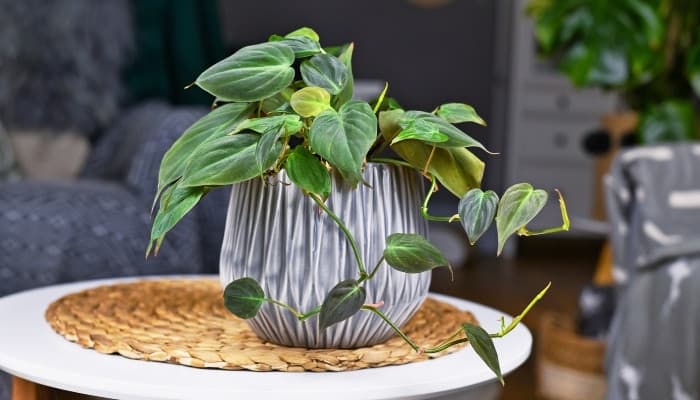
Are Philodendron Micans Rare?
A few years ago, the Philodendron ‘Micans’ was a rare houseplant. Nowadays, the growing popularity has made these plants easier to find.
While you will most likely not find them in a nursery or garden center, they are readily available from online retailers, like Amazon.
How Do You Make Micans Bushier?
Pruning your Philodendron ‘Micans’ will cause the plant to branch off and create a fuller look. Begin pruning the tips of the vines when the plant is young to achieve a bushier aesthetic.
Is Philodendron Micans a Cultivar?
Philodendron ‘Micans’ is a variety of Philodendron hederaceum. A cultivar is a plant that is specifically bred by botanists or hobbyists, so yes, micans philodendron is considered to be a cultivar.
Philodendron Micans vs. Melanochrysum
Philodendron melanochrysum, also known as black gold philodendron, is a separate species from Philodendron ‘Micans’.
While both plants have a velvety appearance, black gold philodendron has elongated leaves that can grow over 12 inches long and the plant can grow to be over 6 feet tall.
Is Philodendron ‘Micans’ the Same as Philodendron ‘Lemon Lime’?
Philodendron ‘Lemon Lime’ is another variety of Philodendron hederaceum. Therefore, it is the same species as Philodendron ‘Micans’, but it is a different variety.
3 Key Tips for Success With Micans Philodendron
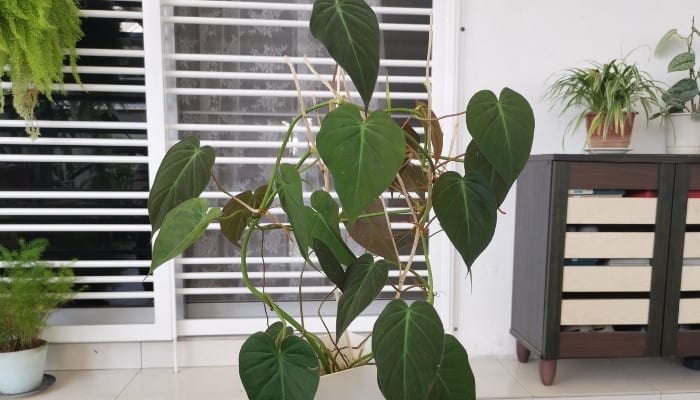
1. Maintain High Humidity
Your micans philodendron will survive in moderate humidity, but if you want your plant to look its best, you should provide high humidity.
2. Provide Adequate Lighting
Even though this plant can survive in lower light levels, it is not recommended. Bright, indirect light will allow the plant to be its healthiest and most beautiful.
3. Keep a Watering Schedule
Drought and overwatering are not a death sentence for micans philodendron, but they are not advised.
Water when the top of the soil is dry, usually once a week during the growing season, to keep your plant as healthy as possible.
A Quick Look Back
Micans philodendron doesn’t ask for too much – a light soil mix, routine watering, indirect light, moderate temperatures, relatively high humidity, and regular feeding.
Now that you know how to care for this plant, you can add those gorgeous, velvety leaves to your collection.
